Ensuring quality and freshness in animal nutrition products
Streamlined quality assurance workflow to quantitate biogenic amines using LC-MS/MS Technology
Karl A. Oetjen1, Oscar G. Cabrices1, Christopher Borton1, Seyed A. Sadjadi2, Scott Krepich2 and Ty Garber3
1SCIEX, USA; 2Phenomenex, USA; 3Phenova, USA
Abstract
A robust LC-MS/MS method analysed using the SCIEX TripleQuad 3500 System for the analysis of Biogenic Amines in food and food products demonstrated good repeatability and linearity for quantitation (over 3 orders of magnitude). Samples were extracted using straightforward SPE method utilizing an ion pairing agent to improve chromatographic separation.
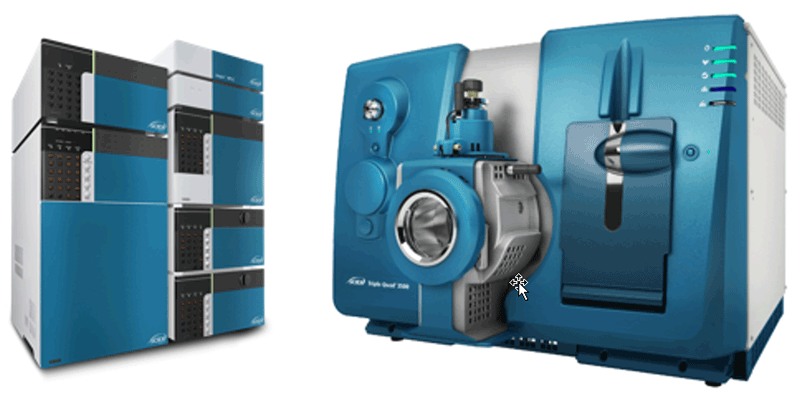
Introduction
Biogenic amines (BAs) can exist in a variety of foods and food products, such as, meat, cheese, vegetables, and wine. BAs are organic bases with aliphatic, aromatic, and heterocyclic structures. These compounds can be formed in food during processing or storage when specific amino acids are released by the action of decarboxylases produced by microorganisms.1,2 Some of the most common BAs found in food are putrescine, cadaverine, histamine, 2-phenylethylamine, tyramine, spermidine, tryptamine, and spermine.1,3
Humans may consume an occasional meal where biogenic amines are elevated however pets on a fixed pet food diet that is high in biogenic amines may have ill effects due to steady exposure. Healthy adult cats and dogs may be able to detoxify biogenic amines present in the diet; however, kittens and puppies, reproducing females and ill animals could potentially be more prone to adverse effects.1
In this study, a sensitive, robust, and fast LC-MS/MS was developed to quantify eight biogenic amines which allows for low level environmentally relevant concentrations to be accurately quantified.
Figure 1. Rapidly detect biogenic amines from a single analysis. Extracted Ion Chromatograms showing the detection of biogenic amines contained in commercially available animal nutrition products. A rapid LC-MS/MS method was used to screen dog food (top) and blood meal (bottom). Compounds like Putrescine, 2-phenylethylamine and Cadavarine were easily detected at concentrations ranging from 1 ppm to 50.6 ppm.
Features of the SCIEX Triple Quad™ 3500 LC-MS/MS System for Quality Assurance in Animal Nutrition
- The SCIEX Triple Quad 3500 LC-MS/MS System is designed for routine food testing assays, enabling the analysis of more compounds in a single injection, lower quantitation limits, and increased sample volume and throughput productivity over conventional HPLC or GC workflow
- Industry leading Turbo V™ Source efficiently ionizes biogenic amines, delivering highly efficient desolvation for stable and sensitive performance while analyzing complex nutritional products (e.g., Blood Meal)
- Proprietary Curtain Gas™ Interface reduces the need for routine maintenance and ensures maximum productivity and robustness
Figure 2. Overview of sample preparation.
Methods
Sample preparation: Approximately 0.5 g of sample was placed in a conical 15 mL tube with 10 mL of 5% trichloroacetic acid (TCA). Samples were then vortexed for 10 min and centrifuged for 10 min. The supernatant was saved, and the extraction repeated using the pellet. The supernatant was combined, and the pH was adjusted to 6 - 7.5 with NaOH. A 1 mL aliquot of methanol (MeOH) was added and the sample was filtered. The solid phase extraction (SPE) was performed using a Strata-XL-CW, 200 mg/6 mL cartridge with a 20 mL reservoir attachment and eluted in methanol and evaporated. The sample was then reconstituted with 0.5% formic acid in water and n-heptane-1-sulfonate.
Commercial pet food samples: Six corn flour samples were prepared with biogenic amines spiked at concentrations ranging from 0.5 to 100 ppm, these samples were analyzed to determine the limits of quantitation and linearity. Additionally, unknown samples of cat food, dog food, chicken meal, blood meal, and chicken-by-product were analyzed.
LC-MS/MS analysis: A 25 µL aliquot of the samples was injected onto an ExionLC™ AC System coupled to a SCIEX Triple Quad 3500 LC-MS/MS System. Chromatographic separation was performed using a Phenomenex Kinetex C18 (100´2.1 mm, 5 mm) analytical column. Mobile phases consisted of formic acid in water (A) and formic acid in methanol (B). Mass spectrometry analysis was performed using positive electrospray ionization.
Data processing using Standard Addition: Results were processed using the SCIEX OS Software. The embedded standard addition algorithm was used. The column “Standard Addition Calculated Concentration” was activated in the Results Table to show the calculated matrix spiked standards.5
Figure 3. Obtain maximum ionization efficiency with LC-MS/MS to ensure best product quality possible. High pressure liquid chromatography (HPLC) coupled with an ultraviolet detector has been successfully employed but has a limited linear dynamic range and requires derivatization steps. In contrast, the approach applied in this study relies on tandem mass spectrometry (MS/MS), thereby added considerable sensitivity and provided structural information, which added certainty in identification. An acidic ion pairing agent, n-heptane-1-sulfonate, was also used, resulting in improved chromatographic separation as shown above.
Implementing a rapid biogenic amines analysis method for quality assurance
The use of the ion pairing agent on the samples was a key element to enable the selective chromatographic separation of all target BAs (Figure 3). Quantitative analysis for all the analytes tested showed good linearity covering 3 orders of magnitude in concentration. Although detection levels lower than the listed Limits of Quantitation were achieved (Table 1), priority was given to levels that represented relevant concentrations in food. Furthermore, the addition of an internal standard would likely widen the linear dynamic range for quantitation.
Table 1. Calibration range of biogenic amines analyzed.
Compound identification was achieved using the ratio of quantifier and qualifier MRM transition. SCIEX OS-MQ Software 1.4 automatically calculates ion ratios, displays tolerance levels, and flags outliers in the result table. An example for the 0.5 ppm standard of histamine is shown in Figure 4.
Proven robustness on toughest food matrices
The SCIEX Triple Quad 3500 System demonstrated excellent reproducibility in matrix. Triplicate injections were performed at 0.5, 1, 5, 10, 25. 50 and 100 mg/L. Relative Standard Deviation (%RSD) was typically below 10% for most compounds (Table 2).
In this study samples several matrices including cat food, dog food, chicken meal, blood meal, and chicken-by-product were extracted and analyzed for select BAs.
The analyzed dog food sample (Figure 1) had concentrations of putrescine, cadaverine, and tryptamine at 46.2 ppm, 50.6 ppm, and 1.7 ppm respectively. Additionally, the concentrations of histamine, tyramine, spermine were 8.0 ppm, 32.1 ppm, and 25.2 ppm. Spermidine and 2- phenylethylamine were below the Limits of Quantitation.
The blood meal samples had concentrations of putrescence, cadaverine, and spermine greater than 100 ppm. While the histamine, 2- phenylethylamine, and tyramine concentrations of 13.7 ppm, 3.4 ppm and 5.1 ppm respectively.
Conclusions
In this study, a robust LC-MS/MS method for the analysis of BAs in food and food products was described. Samples were extracted using straightforward SPE method utilizing an ion pairing agent to improve chromatographic separation. Samples were analysed using the SCIEX Triple Quad 3500 System. Overall, this method demonstrated good repeatability and linearity for quantitation (over 3 orders of magnitude).
Figure 4. Quickly deliver analyte specific information present in an animal nutrition product. View of all compounds present in using SCIEX OS-MQ Software. Here an extracted ion chromatogram obtained for histamine showcasing both MRM transitions overlaying qualifier and quantifier ions with ion ratio lines, at a concentration of 0.5 ppm with maximum tolerances of 20%, which is the industry standard for analyte quantitation and identification.
Table 2. %CV for standard curve samples (n=3).
References
- Analyzing amines - evaluating potential toxicity in pet food ingredients. Pet Food Industry.com website.
- Onal AA, (2007) Review: Current Analytical Methods for the Determination of Biogenic Amines in Foods. Food Chem. 103(4), 1475-1486.
- Sagratini G, et al. (2012) Simultaneous Determination of Eight Underivatized Biogenic Amines in Fish by Solid Phase Extraction and Liquid Chromatography-Tandem Mass Spectrometry. Food Chem, 132 (1), 537-543.
- Download the details for the Bioamines quantification method.
- Standard addition processing simplified with SCIEX OS Software. SCIEX technical note RUO-MKT-07-7660-B.
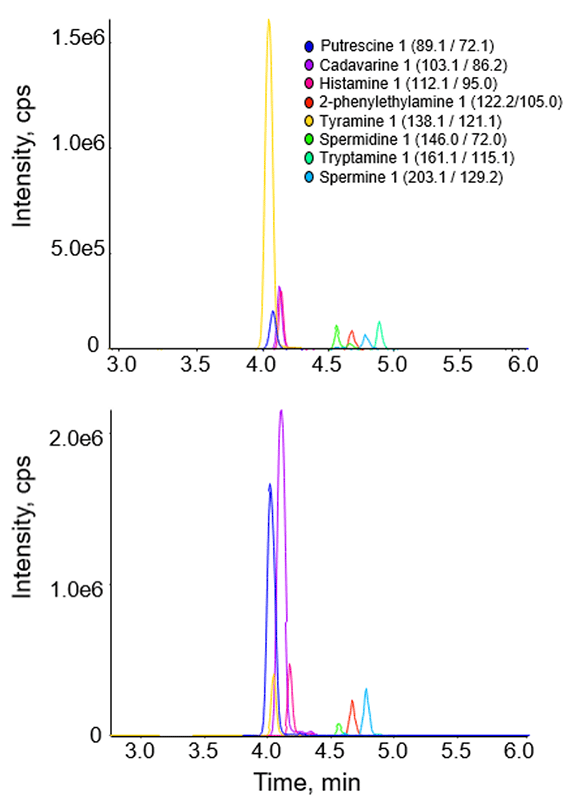 Click to enlarge
Click to enlarge Click to enlarge
Click to enlarge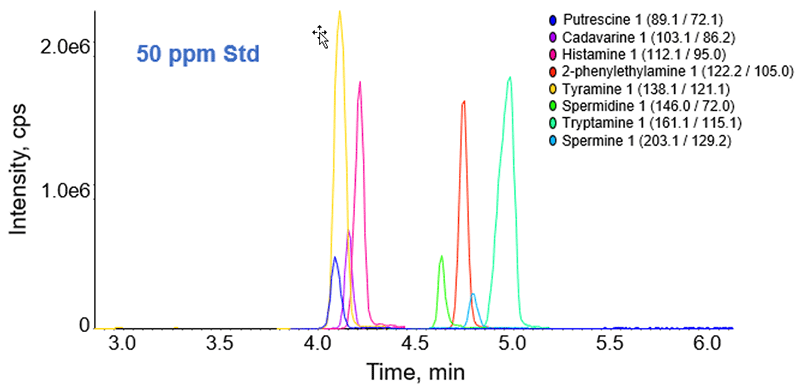 Click to enlarge
Click to enlarge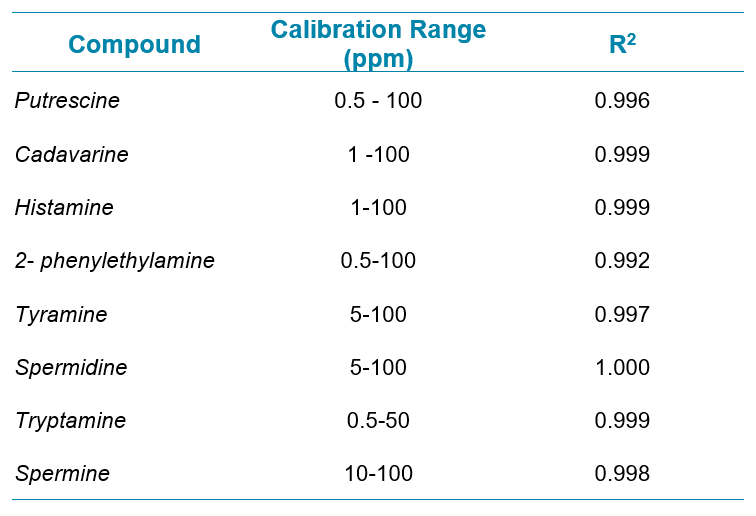 Click to enlarge
Click to enlarge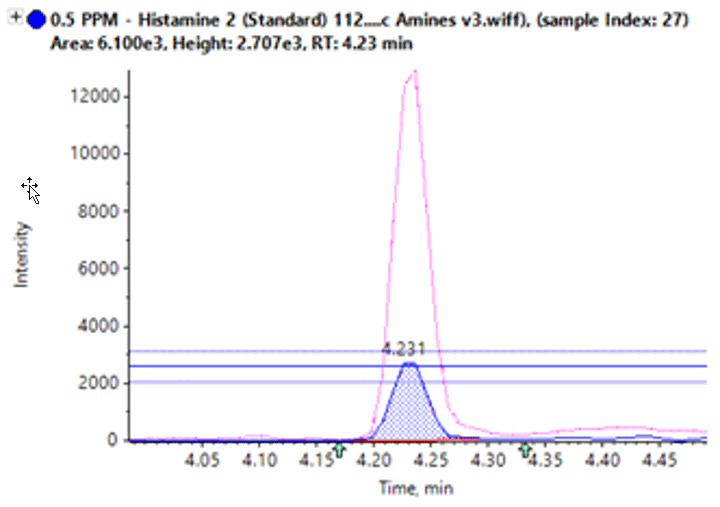 Click to enlarge
Click to enlarge Click to enlarge
Click to enlarge